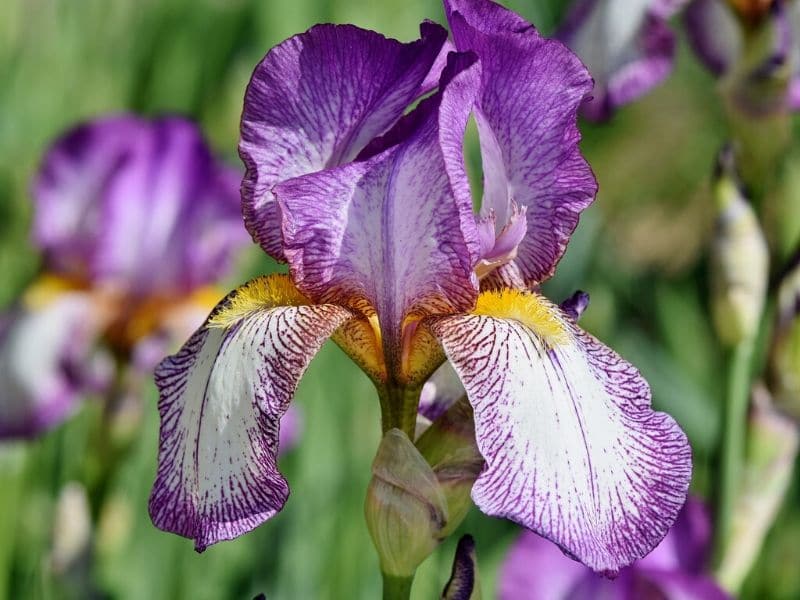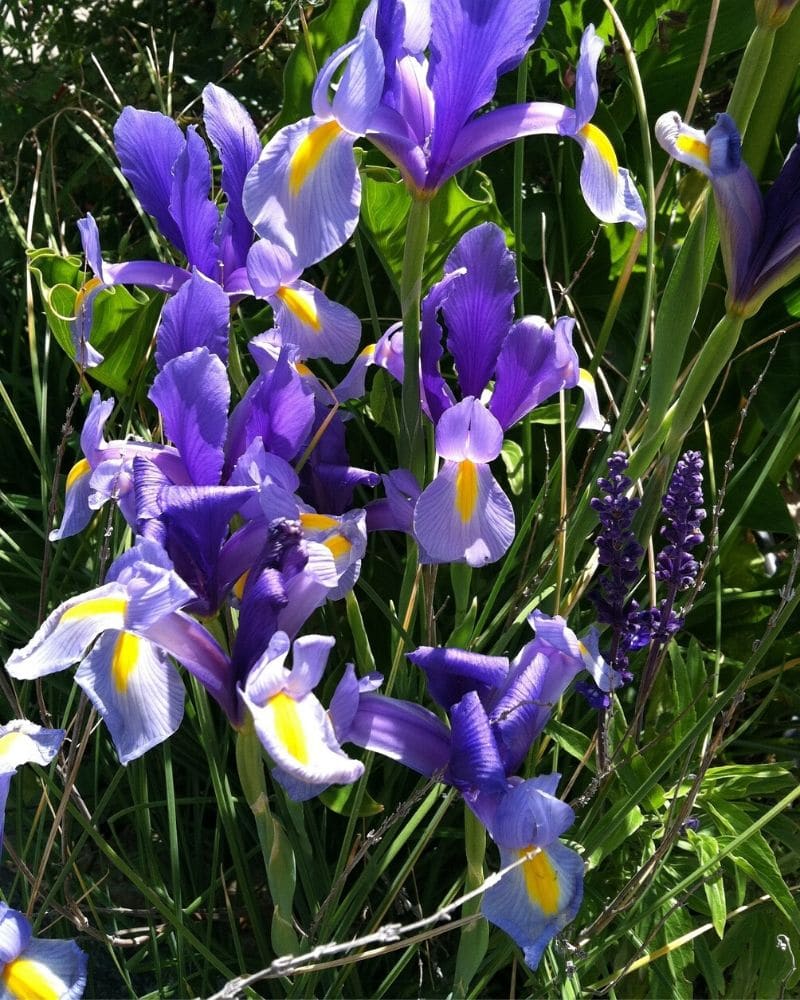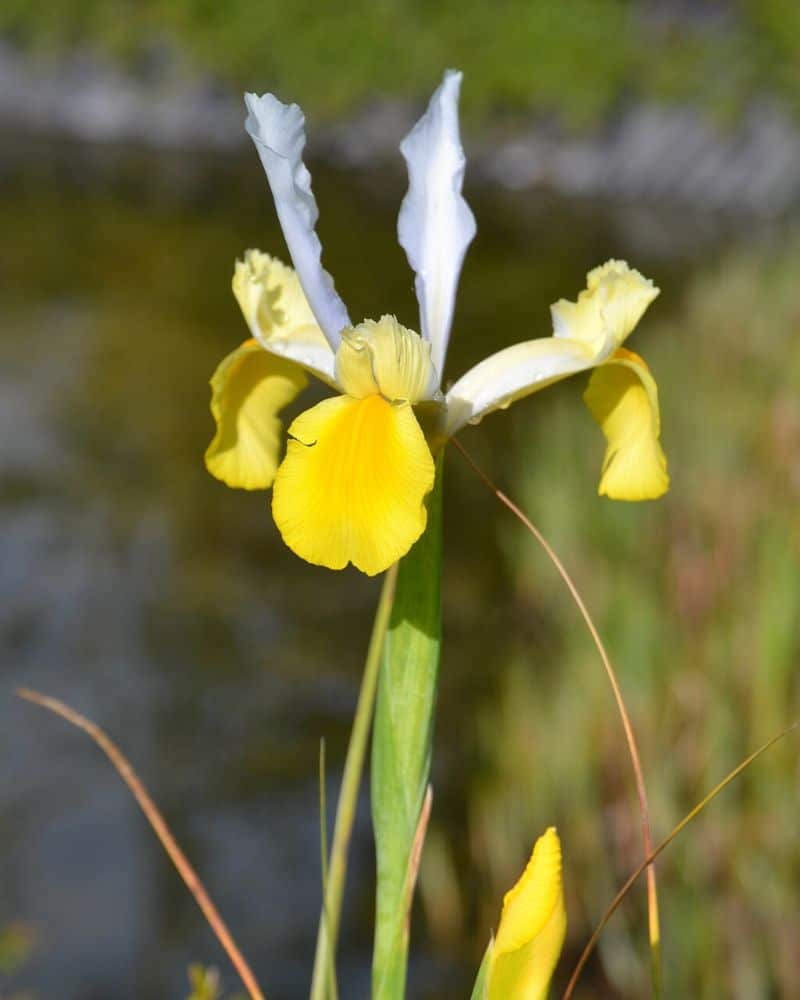Irises have always been a favorite flower choice among florists and gardeners, and I don’t see any reason why they shouldn’t be. These perennials produce unique and undeniably beautiful blooms that carry different meanings and rich history.
Although iris flower bouquets or iris cut flowers are often blue, purple, white, or yellow, there are, in fact, a plethora of colors that fascinating garden irises offer. So, if you’re planning to add a splash of color in your home, then iris plants are worth considering.
Are you interested in growing iris plants but not sure how to start? Worry no more as we’ve got you covered! In this article, you will learn about iris plant facts, different types, and varieties, as well as tips on how to grow them.
Iris Flower Facts

Iris the Flower: Name Origin and History
Iris spp. is the iris flower scientific name. The common name iris refers to one of the most abundant genera of flowering plants in the Iridaceae family. There are currently more or less 300 known species under the Iris genus (1).
Other common names of this popular ornamental plant include flags (for some species) and junos (particularly those from the Scorpiris subgenus).

Irises in Greek Mythology
The name iris means “rainbow” in Greek. It is likewise the name of the goddess in Greek mythology who sends messages between gods and mortals on earth. According to a legend, Iris, the goddess, traveled to earth through a rainbow, and beautiful flowers appeared wherever she set foot on the ground. These flowers were then called iris, like her name (1).
Iris, the goddess, was also believed to be a guide into the afterlife. Because of this belief, it was a common practice in Ancient Greece to place purple irises on graves of women so that Iris, the goddess, could lead them to Elysium. This tradition carries on up to this day.

Significance in Ancient Greece
The use of iris plants in gardens can be traced back to 1469 BC in Egypt. King Thutmose III, Egypt’s 6th pharaoh of the 18th dynasty, was a dedicated gardener who valued plants like gold. When he discovered iris plants growing copiously in Syria during their conquest, he vowed to bring the attractive plant back home in Egypt. Irises soon became a famed garden plant in Egypt, and representations of these flowers were all over Egyptian palaces and gardens (2). For Egyptians, iris plants symbolize the essence and renewal of life (1).
Irises and the French Monarchy
Irises also played a pivotal part in the history of Europe. During the Middle Ages, this exotic flower was almost synonymous with the renowned fleur-de-lis, a symbol of the ruling class. The fleur-de-lis was also the official emblem of King Clovis I of France when he converted to Christianity. Other French monarchs who took the fleur-de-lis as their emblem include King Louis VII and King Charles V (2).

Introduction of Iris Plants to the New World
Iris plants first reached Virginia in the 1600s as the European settlers set foot on the New World (1). Renowned physician Michael Foster was one of the first few Americans fascinated by the iris flower. A known collector and breeder of this plant, Dr. Foster made significant botanical contributions to the world of irises.
A successor and former student of Dr. Foster was botanist and plant breeder William R. Dykes. He advanced the study of iris classification and wrote a book called The Genus Iris (2).
Benefits and Uses of an Iris Flower
Medicinal Uses

Irises are a lot more than their attractive facade. Aside from their aesthetic values, these unique plants are also recognized for their medicinal benefits.
The roots, in particular, are purgative. Moreso, this plant part is used as a relief against lung problems and cough. Pounded roots are made as an ointment for skin ailments, while root infusions are used against liver disorders (2).
Root tea is a conventional treatment for stomach pain, gastric problems, gonorrhea, and kidney and bladder disorders (2).
Garden and Landscape Uses
While there are hundreds of iris species, the most commonly used in landscaping are perhaps the bearded irises.
This type of irises is suitable for plantation planting. They can be planted as beds along an entryway and patios, around the house, or as corner plantings. A combination of different iris hues would surely give an instant boost of attractive colors and fragrant in any home. Growing them in clumps results in a spectacular display of blooms even from afar.

What to plant with iris plants in the garden?
Designing a garden is more of personal preference. But if you think which ornamental plant suits irises best, here are some favorites of many gardeners that complements the beauty of iris flowers.
For a complete list of flowers, see here!
Other Uses
The rhizomes of irises are used for the production of perfumes and incense for religious ceremonies.
General Description and Characteristics of Iris Plants

Iris Flower Description
Iris flowers boast a distinctive structure and appearance that make them stand out among most flowers. Each flower grows from 1 to 2 inches across to 8 to 10 inches across depending on the variety. A plethora of colors are available and often in a combination of two colors (4). Colors of iris flowers include blue, yellow, orange, purple/lavender, red, burgundy, and white (5).
“Standards” and “falls” are flower parts that best describe an iris flower.
Iris flowers grow on a pedicel or peduncle. Standards are the true petals that stand upright like signal flags at the center. Falls, on the other hand, is the downward drooping petal-like sepals that hang down beneath the standards (4).

Iris Leaves
Leaves of iris plants are typically long, erect, and blade-like sheaths. They are deciduous, green, and variegated. Leaf arrangement is rosulate, while individual leaves are lanceolate linear in shape (5). Basal leaves are typically fan-shaped.
Iris Fruits
The fruit of iris plants is a loculicidal capsule, a dry dehiscent type that splits open along the locule (6).
Iris Stems
The stems of these plants are green and non-aromatic (5).
Iris Roots
Irises grow either from bulbs or rhizomes.
Types of Iris Flowers

With hundreds of irises available worldwide, knowing their types and characteristics is perhaps the first step in successfully growing one. Why? Simply because learning about the plant’s basic information paves a way to the proper care and maintenance it needs to thrive and deliver optimum performance.
Let’s start with the basics.
The perennial iris plants generally have two types: bulb irises and rhizome irises. The former type grows from bulbs, while the latter grows from rhizomes – hence the names. This section summarizes the differences between both types, as well as their subcategories.
Bulb Irises
Also called bulbous irises, bulb irises are small and generally early bloomers. Most of them are dormant after blooming (7). Flowers of this type are also smaller than those produced by rhizome irises. Some of the most popular bulbous irises are the Dutch iris and Reticulata iris.
Dutch Iris (Iris hollandica)

Perhaps the most popular type of iris is the Dutch iris or known scientifically as Iris hollandica. It is commonly used as cut flowers by florists across the globe. Part of the Dutch Iris type is several iris hybrids, including the famed Spanish Iris.
Reticulata Iris (Iris reticulata)

Iris reticulata, also known as reticulata iris or reticulated iris, is one of the earliest blooming kind of iris flowers. This iris type is characterized by small, showy flowers and fibrous net surrounding the bulb. It is also called netted iris.
Rhizome Irises
Rhizome irises, which are also called rhizomatous iris flowers, are taller than bulbous irises. They grow up typically up to 3 ft in height and bloom from mid-spring to early summer (7). This type of iris grows horizontally underground or partially under the soil and creates new shoots. The foliage is overlapping and sword-like.
Rhizomatous irises have three main types depending on flower features: bearded, beardless, and crested.
Bearded Iris Flowers

Of the three flower types, bearded irises are perhaps the most popular because they are easy to grow and floriferous. Flowers can be red, pink, blue, purple, white, brown, or black.
The term “bearded” refers to the series of soft hairs arranged in a linear form on each of the falls (4). These beards help guide pollinators toward the flower’s center.
Bearded irises are also called pogon. They have five distinct subcategories, including miniature bearded iris, short bearded iris, intermediate bearded iris, tall bearded iris, and border bearded iris.
Beardless Iris Flowers

Beardless irises have smooth falls and standards, unlike bearded irises (4). Instead of beards, beardless flowers have bright-colored “signals” along the falls to attract pollinators.
They are also called apogon. Although not as showy as bearded irises, this type of rhizomatous irises is more adaptable to a wide range of conditions.
Examples of beardless irises are Japanese Iris, Louisiana Iris, Pacific Coast Natives, Siberian Iris, Spuria Iris hybrids, and Species Iris (or wild irises).
Crested Iris Flowers

Crested iris flowers lack both beards and signals. Instead, their falls have a distinctive yellow or white crest. The crest is a raised tissue called ridge or cockscomb.
Recommended Iris Flower Cultivars
Iris germanica ‘Striking’ (Iris ‘Striking’)
The ‘Striking’ cultivar is one of the most famous tall bearded iris cultivars. A midseason to late-season bloomer Meek hybrid, it flaunts lavender/white standards and falls with coral-tipped beards. It grows up to 34 inches (2.8 ft) in height.
Iris hollandica ‘Apollo’ (Dutch Iris ‘Apollo’)

Dutch Iris ‘Apollo’ features large blooms with white standards and yellow falls with buttercup blotches. A bulb type iris, this cultivar grows about 30 cm (1 ft) to 60 cm (2ft) in height and spreads about 5 cm to 7 cm. Flowering lasts for 2 to 3 weeks in late spring to early summer.
Iris hollandica ‘Blue Magic’ (Dutch Iris ‘Blue Magic’)
The ‘Blue Magic’ cultivar of Dutch iris showcases elegant dark violet-purple blooms with a contrasting hint of yellow on their falls. It typically grows up to 1 to 2 ft in height and spreads up to 7 cm. Flowering occurs in spring.
Iris ‘Beverly Sills’
Iris ‘Beverly Sills’ is an award-winning (a Dykes Medal recipient) cultivar of tall bearded irises. It is an erect iris plant that produces soft flamingo pink blooms with spreading falls. The leaves are green, narrow, sword-shaped, and up to 1 ft long.
Iris germanica ‘Immortality’
With their beautifully ruffled blooms, the Iris ‘Immortality’ cultivar is one of those flowers that quickly get attention. The elegant flowers showcase a spectacle of pure white standards and falls and lemon-yellow beards. The plant grows about 2 to 3 ft in height and spreads up to 2 ft.
The ‘Immortality’ cultivar, which is one of the most popular reblooming irises, is a fast grower and reliable bloomer. It has won multiple awards, including the Honorable Mention award in 1986 and the Award of Merit in 1990.
Growing Irises: Culture, Care, and Maintenance
Irises are among the most popular garden flowers that originated from North temperate America, Europe, and Asia (5). They are herbaceous perennials that are generally deer and rabbit resistant.

Site Selection
Iris plants perform best in fertile soil and full sun. They require at least six hours of full sun per day, while a light afternoon of partial shade helps prevent the colors of the blooms from fading. They also need well-drained soil with a pH between 6.0 to 7.5 (4).
Make sure to plant iris plants in an area with good circulation to minimize disease occurrence. If you want to check your soil quality, using a soil test kit can be helpful.
Planting

Irises reproduce vegetatively through the division of rhizomes with at least one fan attached. Plant the rhizome shallowly underground such that the top part is s exposed to the sun (1). Spread the roots horizontally to support the plant. Plant spacing between irises should be 18 inches.
Make sure that the plants have well-established roots before winter since cold temperatures could result in bud damage. And tall bearded iris varieties should be planted closer to the autumn since they go dormant in early to mid-summer.
Fertilizing
Poorly drained soil conditions could significantly affect the performance of iris plants since these plants are relatively heavy feeders (1). Adress this by adding 1 to 2 inches of compost to a depth of 10 inches before planting to improve water drainage (4).
Generally, iris plants only need a light fertilizer in early spring and another dose a month after flowering. Make sure not to put any fertilizer directly on the rhizomes, since burn may occur(1).
Division
Iris rhizomes generally reproduce rapidly, which results in crowded plants three to five years after planting. When this occurs, divide the plants any time once blooming is completed, or in late summer to fall (1).
But, how do you divide iris plants? Here are the steps:
- Cut the leaves to about one-third their full height.
- Remove iris rhizome clumps from the soil.
- Cut damaged and older rhizomes from the clump.
- Cut the rhizomes into sections of one to two fans.
- Replant the new sections of rhizomes.
Deadheading
Deadheading is often done in reblooming irises to promotes repeat flowering. Removal of stalks and flowers that have just finished blooming allow the plant to allocate its energy to growth rather than seed.
Iris Pests
The most common insect pests of irises are borers. Iris borers feed on the leaves and rhizomes, which results in plant damage (1). Once the rhizomes are infested with borers, they become more susceptible to bacterial soft rot. Borer infestation can be prevented by removing any yellow/dead foliage or insecticide application.
Other insect pests of iris plants include aphids, bud moth, iris weevil, thrips, snails, and slugs.
Iris Diseases
Bacterial soft rot is the most common disease of iris plants. Symptoms include mushy rhizomes that emit an unpleasant odor. Crown rot is another common disease of irises. It is similar to bacterial soft rot, except for the foul smell. It causes the softening of rhizomes and the appearance of small cream to tan spots on the base of the leaves.
To prevent the spread of these diseases, remove yellowing leaves and debris.
Other common diseases of this perennial include crown rot, bacterial leaf blight, fungal leaf spot, and fungal root crown.
FAQs
What does iris flower symbolize?
The iris symbolizes faith, wisdom, and courage, but its specific meaning can depend on the color: purple for wisdom, blue for hope and faith, white for purity, and yellow for passion. A mix of colors represents diverse virtues.

How many times does an iris flower?
Most iris plants flower in early summer, but there are remontant varieties called reblooming irises, which rebloom later in the summer or fall. Reblooming irises have several types: rebloomers, cycle rebloomers, repeaters, and all-season rebloomers.
Rebloomers produce two or more flushes of flowers in a year. Cycle rebloomers, on the other hand, flower in spring, then rest during summer, and flower again in fall.
Repeaters refer to irises that showcase new blooms soon after the dieback of the first batch of spring flowers, extending the flowering period to one or two more months. All-season rebloomers are irises that bloom irregularly throughout the season.
Are iris flowers poisonous?
Iris are mildly poisonous if eaten. The roots, seeds, and sap contain harmful toxins named irisin, iridin, and irisine, which result in contact dermatitis or skin irritation upon contact. Consumption of iris also causes nausea, vomiting, diarrhea, abdominal pain, and an increase in body temperature (5).
Conclusion
Choosing the right ornamental for your garden shouldn’t be tricky. But if you’re still a little unsure, one option that definitely is a no-fail garden plant is the iris plant.
The famed herbaceous perennial is relatively easy to grow. It offers lots of options when it comes to cultivars, colors, and types – from dwarf varieties to tall ones or purple flowers to blue, white, pink, and other colors.
With the characteristics of these blooms mentioned in this article, irises are a sure way to add colors and fragrance in your home. Read our article on perennial plants and flowers for more information about flowers similar to irises.
See more: What to plant in front of irises
References
Reference List:
- Ipm.missouri.edu. (2020). Iris: A Brief History (David Trinklein). [online] Available at: https://ipm.missouri.edu/MEG/2014/6/Iris-A-Brief-History/
- Cumo, C. (n.d.). Encyclopedia of Cultivated Plants [3 volumes]: From Acacia to Zinnia.
- Cals.arizona.edu. (2020). Using Bearded Iris in Your Landscape | Cochise County Master Gardeners. [online] Available at: https://cals.arizona.edu/cochise/mg/using-bearded-iris-your-landscape
- Extension.unl.edu. (2020). [online] Available at: https://extension.unl.edu/statewide/douglas-sarpy/pdfs/ce/resources/ce-g1741-culture-of-iris.pdf
- Plants.ces.ncsu.edu. (2020). Iris (Iris) | North Carolina Extension Gardener Plant Toolbox. [online] Available at: https://plants.ces.ncsu.edu/plants/iris/
- Botany.hawaii.edu. (2020). Flowering Plant Families, UH Botany. [online] Available at: http://www.botany.hawaii.edu/faculty/carr/irid.htm
- Extension.uga.edu. (2020). Flowering Bulbs for Georgia Gardens | UGA Cooperative Extension. [online] Available at: https://extension.uga.edu/publications/detail.html?number=B918&title=Flowering%20Bulbs%20for%20Georgia%20Gardens
Close







